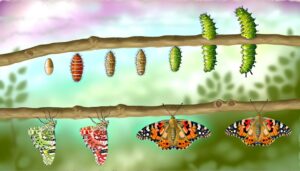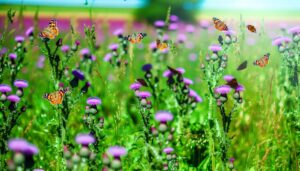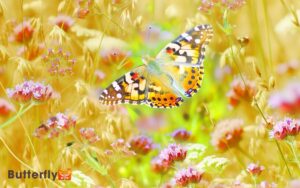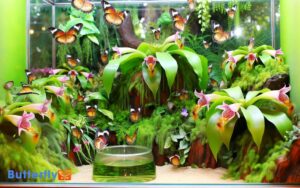Male Vs Female Painted Lady Butterfly? Key Differences!
Male and female Painted Lady butterflies (*Vanessa cardui*) display distinct differences. Males exhibit vibrant, saturated wing coloration with prominent black and white spots, while females have subdued hues and larger abdomens for egg production.
Males show vivid eye spots on hindwings, aiding in mating displays, whereas females have intricate color mosaics for camouflage.
Females are generally larger, reflecting their role in reproduction. Courtship involves males performing flight patterns and releasing pheromones, with females selecting mates based on these displays.
These sexually dimorphic traits highlight the species’ adaptive strategies, inviting further exploration into their fascinating behaviors and ecological roles.
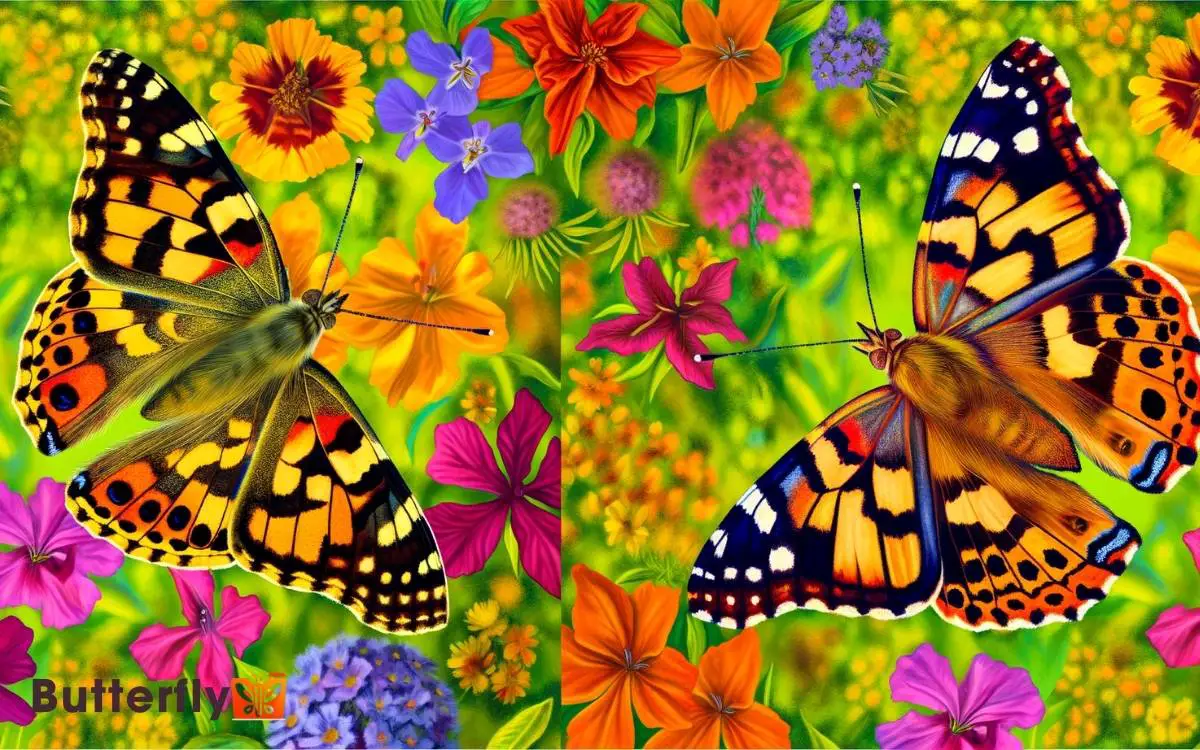
Key Takeaways
Physical Appearance
The physical appearance of male and female Painted Lady butterflies (Vanessa cardui) exhibits subtle but distinct differences that can be observed in their wing coloration and patterns.
Males typically display a more vibrant and saturated coloration, particularly in the orange and black regions of their wings. This enhanced pigmentation is thought to play a role in mating displays.
Females, on the other hand, often possess slightly larger abdomens, which accommodate their reproductive organs. Additionally, females may exhibit a comparatively muted color palette, providing better camouflage while they lay eggs.
These morphological characteristics aren’t only crucial for identification but also for understanding their roles in reproduction and survival within their respective ecological niches.
Wing Patterns
Wing patterns in Painted Lady butterflies exhibit sexually dimorphic traits that aid in distinguishing males from females. Males typically have more vivid and well-defined coloration on their wings, with distinct black and white spots on the forewings.
These spots contrast sharply against the orange and brown background, serving both as territorial markers and mating signals.
Females, on the other hand, display more subdued hues with less pronounced markings. Their forewings feature a more intricate mosaic of colors that blend together, providing better camouflage against predators. The hindwings of both sexes possess eye spots, but these are generally more prominent in males.
These sexually dimorphic wing patterns not only facilitate mating but also play an important role in predator avoidance and environmental adaptation.
Size Differences
In addition to wing pattern differences, male and female Painted Lady butterflies exhibit significant size variations, with females generally being larger and possessing a broader wingspan than their male counterparts.
Females typically have a wingspan ranging from 5.5 to 10 centimeters, while males usually range from 5 to 9 centimeters. This size disparity isn’t merely important; it influences reproductive roles and behaviors.
Larger body size in females supports egg production and enhances fecundity. Males, being slightly smaller, possess greater agility, facilitating territorial defense and mating pursuits.
These morphological differences are vital for understanding the species’ reproductive strategies and ecological adaptations.
Observing these size variations aids in accurate sex identification and contributes to broader lepidopteran studies.
Color Variations
Color variations in the Painted Lady butterfly (Vanessa cardui) are evident through distinct wing pattern differences between males and females. Males typically exhibit more intense hues, particularly in the orange and black regions of their wings. Females, on the other hand, often display slightly muted tones with more intricate patterns, aiding in camouflage. These variations help in distinguishing sexes and may play a role in mating strategies. When comparing the painted lady vs red admiral, the latter tends to have darker, more defined markings with bold red bands contrasting against black wings.
Additionally, seasonal color changes influence the vibrancy and visibility of these patterns, reflecting environmental adaptations.
Wing Pattern Differences
Distinctive variations in wing patterns between male and female Painted Lady butterflies can be observed, particularly in the arrangement and intensity of color spots and bands.
Male butterflies generally exhibit more pronounced and sharply defined black spots on their forewings. In contrast, females display more diffuse and less distinct black markings.
Additionally, females often have broader orange bands on their hindwings compared to males, providing a subtle yet noticeable differentiation.
| Wing Aspect | Male Characteristics | Female Characteristics |
|---|---|---|
| Forewing Spots | Pronounced, sharply defined black spots | Diffuse, less distinct black markings |
| Hindwing Bands | Narrower orange bands | Broader orange bands |
| Overall Pattern | More contrasting | Less contrasting |
These distinctions aid in the identification and study of sexual dimorphism within the species.
Hue Intensity Variations
Apart from the wing pattern differences, variations in hue intensity between male and female Painted Lady butterflies further illustrate sexual dimorphism, with males typically exhibiting more vibrant and saturated colors.
Males display a brighter orange on the dorsal wing surfaces, juxtaposed with females’ more subdued hues. This enhanced coloration in males is thought to play a role in mate attraction.
Additionally, males often possess more pronounced black and white patterning, contributing to their overall vivid appearance.
Females, conversely, exhibit a more cryptic coloration, which may aid in camouflage during oviposition.
These chromatic distinctions are significant for species identification, as they provide clear visual markers that differentiate the sexes, aiding in behavioral and ecological studies of Vanessa cardui.
Seasonal Color Changes
Throughout the year, Painted Lady butterflies (Vanessa cardui) exhibit notable color variations influenced by seasonal changes, which affect both their dorsal and ventral wing surfaces.
In warmer months, the dorsal forewings display brighter orange with more distinct black spots, enhancing their visibility and aiding in thermoregulation.
Conversely, during cooler periods, the coloration tends to be duller, with muted tones of brown and tan predominating. This seasonal dimorphism is more pronounced in females, whose coloration adapts to optimize camouflage during egg-laying.
The ventral wing surfaces also show variability, with winter morphs exhibiting more cryptic patterns that blend into the environment, reducing predation risk.
These adaptations underscore the Painted Lady’s remarkable phenotypic plasticity, allowing survival across diverse habitats and climatic conditions.
Courtship Behaviors
Male painted lady butterflies actively engage in a series of intricate flight patterns and pheromone releases to court females. These behaviors are pivotal in their mating rituals.
The males exhibit rapid, darting flights to capture the attention of potential mates. They also hover near females, releasing specific pheromones from specialized scent scales located on their wings. These chemical signals play an important role in female attraction and selection.
Observations reveal that females respond by either accepting or rejecting the male’s advances, often based on the intensity and quality of the courtship display.
This complex interplay guarantees that only the most fit males succeed in attracting mates, thereby contributing to the species’ evolutionary fitness and genetic diversity.
Reproduction Roles
In the reproduction roles of painted lady butterflies, females primarily focus on selecting the best oviposition sites to guarantee the survival and development of their offspring.
They meticulously evaluate host plants, considering factors like leaf texture, chemical composition, and plant health. This behavior secures larvae have ideal conditions for growth.
Males, on the other hand, are tasked with locating receptive females to guarantee successful mating. They patrol territories and engage in competitive displays to secure mates.
Males exhibit territoriality, often defending specific areas abundant with nectar sources to attract females.
Through these distinct reproductive strategies, both sexes contribute to the continuation of the species, with females securing suitable environments for egg-laying, and males maximizing mating opportunities.
Habitat Preferences
Male and female Painted Lady butterflies exhibit distinct habitat preferences influenced by urban versus rural environments, temperature, and climate.
Males often inhabit open areas with abundant sunlight to patrol for females, while females prioritize locating suitable host plants for oviposition.
Both sexes’ distribution patterns are intricately linked to climatic conditions, which affect their survival and reproductive success.
Urban Vs Rural Environments
Urban and rural environments offer distinct advantages and challenges that influence the habitat preferences of the Painted Lady butterfly.
Urban landscapes, with their diverse floral assemblages, provide abundant nectar sources, which are crucial for adult butterflies. However, urban areas also present increased risks such as pollution and habitat fragmentation.
In contrast, rural environments offer expansive, uninterrupted habitats with ample host plants like thistles (Cirsium spp.) and nettles (Urtica spp.), essential for larval development.
Male Painted Ladies often patrol open spaces in rural areas, optimizing mate location, while females prefer areas rich in host plants for oviposition.
Understanding these habitat preferences informs conservation strategies, ensuring suitable environments for both male and female Painted Lady butterflies.
Temperature and Climate Impact
Temperature and climate greatly influence the habitat preferences and distribution patterns of the Painted Lady butterfly (Vanessa cardui).
These butterflies exhibit remarkable adaptability, thriving in diverse climates from temperate to tropical regions. They favor warmer temperatures, which accelerate their development and increase survival rates.
Climate changes, such as global warming, can expand their range northward but may also lead to habitat fragmentation.
Males and females don’t differ importantly in their thermal preferences, both seeking best microclimates for mating and oviposition. During cool seasons, they migrate to milder climates, showcasing their resilience.
Observations show that temperature fluctuations affect their phenology, influencing breeding cycles and migratory behaviors. Therefore, climatic conditions are important in determining their geographic and seasonal presence.
Host Plant Preferences
Painted Lady butterflies (Vanessa cardui) exhibit strong host plant preferences, primarily favoring species within the Asteraceae family for oviposition and larval development.
Females display selective behavior when choosing host plants, ensuring ideal conditions for their offspring.
Key observations include:
- Plant Selection: Females prefer plants like thistles (Cirsium spp.) and other Asteraceae members due to their nutritional adequacy.
- Larval Survival: Host plants from the Asteraceae family enhance larval survival rates by providing essential nutrients.
- Habitat Suitability: These plants are abundant in diverse habitats, aiding in the widespread distribution of Vanessa cardui.
This preference for Asteraceae significantly impacts the butterflies’ reproductive success and geographic range, underscoring the importance of host plant availability in their lifecycle.
Lifespan
The average lifespan of a Painted Lady butterfly, scientifically known as Vanessa cardui, ranges from 2 to 4 weeks, depending on environmental factors and predation.
Males and females exhibit similar lifespans, though their roles during this period differ. Males primarily focus on locating females for mating, often patrolling territories and engaging in aggressive behaviors to ward off rivals.
Females dedicate their time to oviposition, selecting appropriate host plants to guarantee larval survival. Factors such as temperature, humidity, and availability of nectar sources greatly impact their longevity.
Predators, including birds and spiders, also play a critical role in determining their lifespan. Despite their brief existence, both sexes contribute significantly to the species’ reproductive success and ecological presence.
Conclusion
In the grand soap opera of Vanessa cardui, males flaunt their slightly larger wings, perhaps overcompensating for their duller hues.
Females, though smaller, exhibit vibrant patterns, wooing males with a flair for the dramatic. Their courtship is a dance of deception, ending in reproductive roles that scream gender stereotypes.
Habitat preferences? Mere stage settings for their fleeting, two-week lifespans.
Ah, the painted lady butterfly, nature’s flamboyant nod to our own societal absurdities, wrapped in scientific nomenclature.

